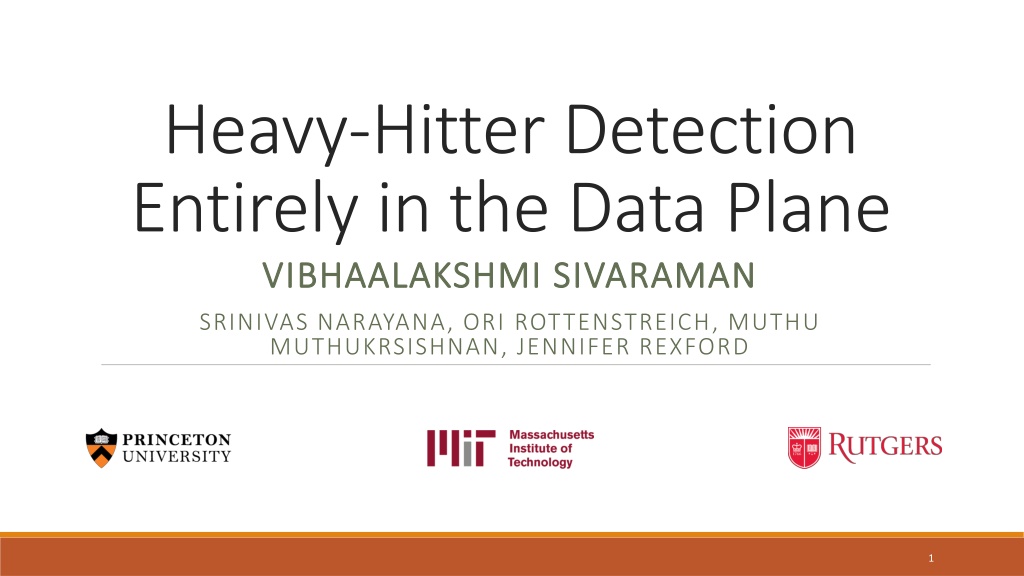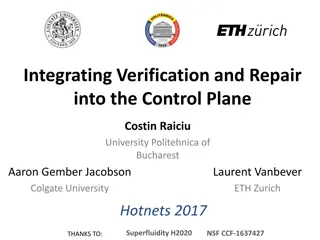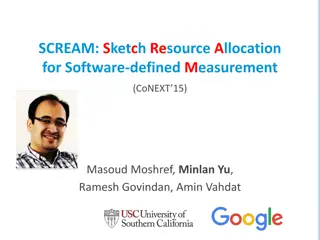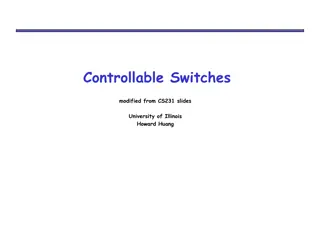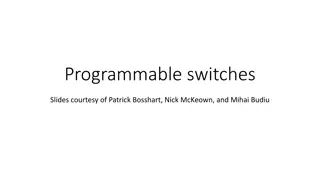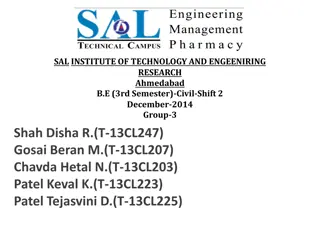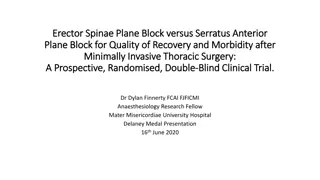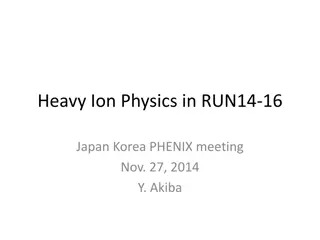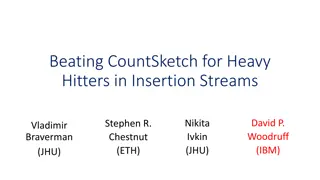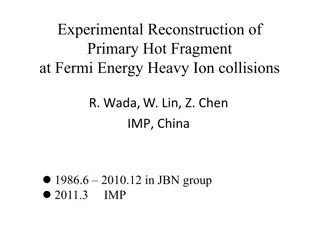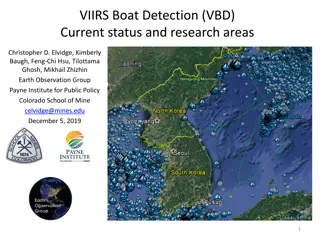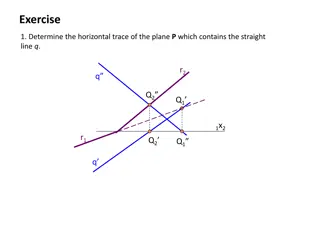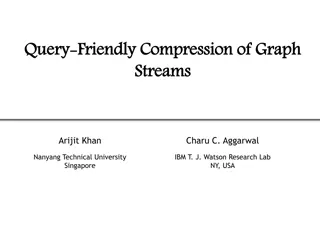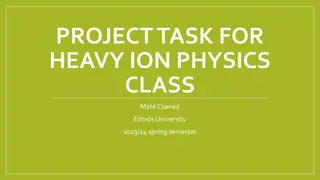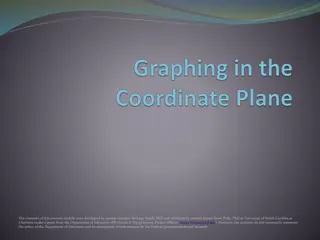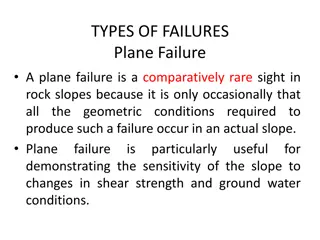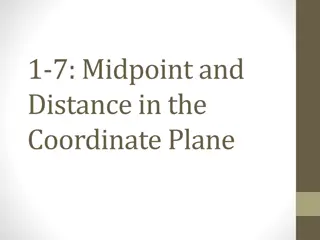Data Plane Heavy Hitter Detection and Switches: A Comprehensive Overview
In this comprehensive guide, explore the concepts of heavy-hitter detection entirely in the data plane, the significance of detecting heavy hitters, emerging programmable switches, existing techniques, and constraints faced in processing heavy flows. Discover the motivation behind the Space-Saving Algorithm for efficient computation of frequent and top-k elements in data streams. Dive into discussions on trouble-shooting, anomaly detection, dynamic routing, low data plane state, high accuracy, and line-rate packet processing.
Download Presentation

Please find below an Image/Link to download the presentation.
The content on the website is provided AS IS for your information and personal use only. It may not be sold, licensed, or shared on other websites without obtaining consent from the author. Download presentation by click this link. If you encounter any issues during the download, it is possible that the publisher has removed the file from their server.
E N D
Presentation Transcript
Heavy-Hitter Detection Entirely in the Data Plane VIBHAALAKSHMI SIVARAMAN VIBHAALAKSHMI SIVARAMAN SRINIVAS NARAYANA, ORI ROTTENSTREICH, MUTHU MUTHUKRSISHNAN, JENNIFER REXFORD 1
Heavy Hitter Flows Flows above a certain threshold of total packets Top-k flows by size Port: 22, Count: 100 Port: 30, Count: 200 k = 2 Port: 15, Count: 200 Port: 80, Count: 100 2
Why detect heavy hitters? Trouble-shooting and anomaly detection Dynamic routing or scheduling of heavy flows f1 f1 Flow Count f2 f2 f1 100 f2 75 f3 5 3
Problem Statement Restrict processing to data plane Low data plane state High accuracy Line-rate packet processing 4
Emerging Programmable Switches Programmable switches with stateful memory Basic arithmetic on stored state Pipelined operations over multiple stages State carried in packets across stages Stage 2 Stage 1 Stage 3 Stage 4 Packet p 5
Constraints Small, deterministic time budget for packet processing at each stage Limited number of accesses to stateful memory per stage Limited amount of memory per stage No packet recirculation 6
Existing Work Technique Pros Cons Sampling-based (Netflow, sflow, Sample & Hold) Small flow memory to track heavy flows Underestimates counts for heavy flows Sketching-based (Count, Count-Min, Reversible) Statistics for all flows in single data structure No flow identifier to count association Counting-based (Space Saving, Misra-Gries) Summary structure with heavy flow ids and counters Occasional updates to multiple counters 7
Motivation: Space-Saving Algorithm1 O(k) space to store heavy flows Provable guarantees on accuracy Evict the minimum to insert new flow Multiple reads but exactly one write per packet 1Metwally, Ahmed, Divyakant Agrawal, and Amr El Abbadi. "Efficient computation of frequent and top-k elements in data streams." International Conference on Database Theory. Springer Berlin Heidelberg, 2005. 8
Space Saving Algorithm Flow Id Packet Count Flow Id Packet Count High accuracy Exactly one write K1 4 K1 4 K2 2 K2 2 K3 7 K3 7 New Key K6 K4 10 K4 10 K5 1 Entire table scan Complex data structures K6 2 9
Towards HashPipe Technique Pros Cons Space-Saving High accuracy; Exactly one write-back Entire table scan; Complex data structures HashParallel Sample fixed number of locations; Approximate minimum Multiple reads per stage; Dependent write-back Sequential Minimum Computation Hash table spread across multiple stages; Sample one location per stage Multiple passes through the pipeline 10
Our Solution - HashPipe Always insert new key in the first stage Hash to index to a location Carry evicted key to the next stage Stage 2 Stage 3 Stage 1 K2 3 G 4 A 5 New key K D 15 K3 3 K1 4 E 25 H 10 B 6 h1 (K) -> K1 F 100 I 9 C 10 11
Our Solution - HashPipe At each later stage, carry current minimum key Hash on carried key to index to a location Compare against key in location for local minimum Stage 2 Stage 3 Stage 1 D 3 G 4 A 5 E 15 K3 3 K 1 (K1, 4) K2 25 H 10 B 6 F 100 I 9 C 10 12
HashPipe At any table stage, retain the heavier hitter h2(K1) -> K2 Max(K1, K2) -> K2 Stage 2 Stage 3 Stage 1 D 3 G 4 A 5 E 15 K3 3 K 1 (K1, 4) K2 25 H 10 B 6 F 100 I 9 C 10 13
HashPipe At any table stage, retain the heavier hitter h3(K1) -> K3 Max(K1, K3) -> K1 Stage 2 Stage 3 Stage 1 D 3 G 4 A 5 (K1, 4) E 15 K3 3 K 1 K2 25 H 10 B 6 F 100 I 9 C 10 14
HashPipe At any table stage, retain the heavier hitter High accuracy Single pass One read/write per stage Eventually evict a relatively small flow Stage 2 Stage 3 Stage 1 D 3 G 4 A 5 E 15 K1 4 K 1 K2 25 H 10 B 6 F 100 I 9 C 10 Duplicates 15
HashPipe Summary Split hash table into d stages Condition Stage 1 Stages 2 - d Empty Insert with value 1 Insert key and value carried Match Increment value by 1 Coalesce value carried with value in table Mismatch Insert new key with value 1, evict and carry key in table Keep key with higher value and carry the other 16
Implementation Prototyped on P4 Packet metadata Register arrays Hash on packet header Stage 2 Stage 3 Stage 1 New key K K2 3 G 4 A 5 D 15 H 3 K1 4 (K1, 4) E 25 K3 10 B 6 F 100 I 9 C 10 Conditional updates to compute minimum 17
Evaluation Setup Top-k 5 tuples on CAIDA traffic traces with 500M packets 50 trials, each 20 s long with 10M packets and 400,000 flows Memory allocated: 10 KB to 100 KB; k value: 60 to 300 Metrics: false negatives, false positives, count estimation error 18
Tuning HashPipe k = 210 5040 flowids maintained in table 19
HashPipe Accuracy 5-10% false negatives for detecting heavy hitters 20
HashPipe Accuracy 5-10% false negatives for the detecting heavy hitters 4500 flow counters on traces with 400,000 flows 21
HashPipe Accuracy 5-10% false negatives for the detecting heavy hitters 4500 flow counters on traces with 400,000 flows 22
Competing Schemes Sample and Hold Sample packets of new flows Increment counters for all packets of a flow once sampled Count-Min Sketch Increment counters for every packet at d hashed locations Estimate using minimum among d location Track heavy hitters in cache 23
Contributions and Future Work Contributions: o Heavy hitter detection on programmable data planes o Pipelined hash table with preferential eviction of smaller flows o P4 prototype - https://github.com/vibhaa/iw15-heavyhitters Future Work: o Analytical results and theoretical bounds o Controlled experiments on synthetic traces 27
THANK YOU vibhaa@princeton.edu 28
HashPipe vs Idealized Schemes Performance of three schemes is comparable HashPipe may outperform SpaceSaving 32
Programmable Switches New switches that allow us to run novel algorithms Barefoot Tofino, RMT, Xilinx, Netronome, etc. Languages like P4 to program the switches 33
